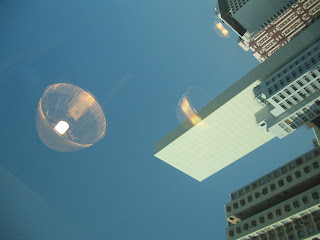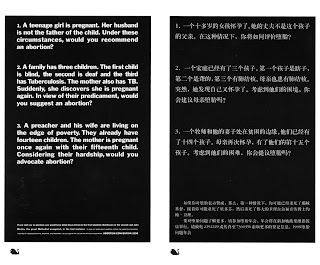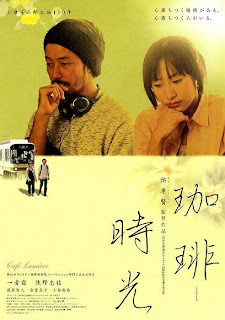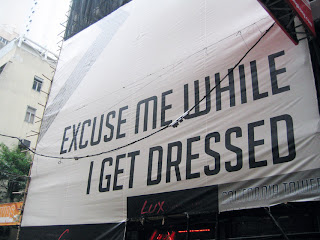
Sunday, December 16, 2007
AWAKENING

Friday, November 23, 2007
microwave'07: luminous echo

 Top: Daan Roosegaarde - Dune 4.1
Top: Daan Roosegaarde - Dune 4.1Bottom: Simon Heijdens - Reed
太忙了,本打算錯過今屆的展覽,最後還是抽了點時間到大會堂看了其中一場。
這個名為《形光譜》的展覽共展出了八位藝術家的作品,主題都與聲音有關,作品透過觀眾的反應來產生不同的聲效,從而刺激其感官、神經以至思維;然而許多互動裝置似乎都存在着一共通問題:過分側重於感受層面而忽略了深層的訊息傳遞。
我不是說官能刺激不重要,在互動裝置藝術的領域裡,那是不可或缺的層面,但這些令人躍躍欲試的感受本身為的是要帶領觀眾進入另一層次的思考,而非單純的感官認知,藝術從來要帶出的都是形而上的東西,照顧的是我們的精神,不是肉體;若然一個由互動裝置構成的「符號」只有第一層的denotation,而沒有了第二層的connotation的話,它不應被視為一藝術品,只能說是科技罷了。
為什麼我們都得把藝術品放在安靜的環境來欣賞?因為只有在安靜的環境下我們的大腦才會有足夠的空間去思考、咀嚼它們,要想跟這些「死物」交心的話,觀眾必須先安靜下來;而互動裝置本身就不完全是「死」的,許多都充滿着玩味性,一方面容易吸引觀眾的注意,但同時亦分散了觀眾專一思想作品的能耐,要作深層的思考,或許都是事後的事。加上展覽場地的局限,作品與作品之間的距離接近,所產生的聲音容易與其他作品混雜,觀眾的解讀就更容易受到影響。
展覽中一件由Daan Roosegaarde製作的Dune 4.1,讓我想起了Simon Heijdens的Reed,兩者都嘗試將自然帶到石屎森林之中,不同的是前者由觀眾引發互動,後者則是透過展覽場外的自然風,觀眾只能感受卻未能參與其中,當觀眾完全地以旁觀者的角度去欣賞時,不就更能看「清」一點?試問有多少個陶醉於電玩的人會思考他們與科技的關係?
Wednesday, November 14, 2007
Decoding "Ratatouille"
Monday, November 12, 2007
The Death of the Author
"...a text is not a line of words releasing a single 'theological' meaning but a multi-dimensional space in which a variety of writings, none of them original, blend and clash."
- Roland Barthes
Wednesday, October 31, 2007
《Fetish》 攝影展
女‧人?
Thursday, October 25, 2007
Jackie Chan vs Naruto

Though not many people from my generation admire Jackie Chan but simply no one could argue about his popularity worldwide. At least those Japanese animators, when visualizing the fighting scenes, learnt that they could make reference from Jackie's movies. Someone doubted if it's a pastiche, but I think it's just a kind of intertextuality that happens in our day-to-day creation. After all, designer's database is not infinite and that's why research is playing an increasingly essential role in a design process. In a sense, we could never claim our work as original.
One of my MA classmates tried to allegorize Jackie with McDonald's in last lecture. What a great metaphor! You see him everywhere but you know you'll never love him! I remember when McDonald's first launched its "i'm lovin' it!" campaign, one of my design tutors who specialized in branding strategy was so much annoyed by the slogan. It's such a fake emotion imposed upon the public. That is how advertising works! They are inoculating you with concepts that you didn't buy. After persistent bombarding, you'll soon be anaesthetized and kind of accept what they sell no matter how hypocritical their concept sounds.
Friday, October 19, 2007
Ang Lee on "Lust, Caution"
 Well, didn't expect this film to have aroused so many controversies, though almost everyone is talking ONLY about its sex scenes and from the following phone interview by Newsweek, it's perfectly sure that Ang had calculated that result. Right, "they usually are functional"...
Well, didn't expect this film to have aroused so many controversies, though almost everyone is talking ONLY about its sex scenes and from the following phone interview by Newsweek, it's perfectly sure that Ang had calculated that result. Right, "they usually are functional"...What appealed to you about Chang's story?
Very little Chinese literature describes sex. It is one of the few daring ones. It tells us what women get from sex. It scared me for quite a few years, but I decided to do it.
How was making "Brokeback Mountain" different from "Lust, Caution"?
The material if "Brokeback Mountain" is very far away from me. I mean, American gay cowboy, that's as far as you get from my personal experience. I was able to make art out of it. Physically I was very relaxed making it. But with "Lust, Caution", the materials, the characters and the textures are very close to me. It's very intense physically. It reminds me where my culture comes from.
What was the hardest part?
Well, obviously, the sex scenes. You can't just take it easy because people make pornographic films. It's very difficult physically and psychologically. People think you have the framework, and then you decide how deep you want to go with the sex scenes because they usually are functional. But to me how they landed decided how the movie would unfold. So I actually shot them relatively early. Then they served as the anchors to decide how to craft the second half of the story.
Philosophically, what is filmmaking to you?
It's the way I discover myself and understand the world.
(adapted from Newsweek Oct 15, 2007)
Wednesday, October 17, 2007
《等候董建華發落》

找來一套還沒看過的電影作為第二份論文的分析文本,似乎有點冒險,告訴教授的時候連片子的英文名也想不起來,幸好身旁一位好心的同學給我道出了導演的名字,選材方能過關,可見邱禮濤(Herman Yau)的電影有質素上的保證。
許久沒看過這樣勇敢的電影,幾幕直接控訴政府官僚及社會體制的場面真是爽極了!不難想像當年此片要經過多少障礙才得以成功發行。基本上它可被界定為一套Docudrama,因大部份內容均由實際發生之事件改編而成,驟看有點《警訊》或《鏗鏘集》的影子。全片剛好一百分鐘,是帶動觀眾進入情緒的標準長度,程度深淺,因人而異,就此片而言,我想我是屬於較深的一類,那不是一般荷里活電影以特技或音效堆砌出來的感傷情緒,明顯地導演也儘量避開了這樣的處理手法,使影片更富真實性,特別是一些解釋現行法例的場面,演員都特意放慢了說話的速度,讓觀眾有充足的時間咀嚼內容,雖然某些對白顯得冗長,含有數據的尤甚,但可見導演冀盼觀眾了解事件的心何其迫切,他也在片中自嘲像拍教育電視一樣,要說教,只好犧牲一點劇情片應有的戲劇性。
青少年罪犯以及內地來港定居人士,都是普遍被社會忽略甚至鄙視的一群,導演嘗試從這些小眾的角度出發,引申多個香港在經濟起飛背後潛藏的社會問題。廿三個頑童的年幼無知,卻反映了成人世界的自相矛盾和腐敗無能──我們一邊歸咎青年人自甘墮落,沒好好潔身自愛,另一邊箱卻在不斷製造各式各樣的試探來誘惑心智未成熟的一群犯罪,讓他們成了資本主義社會下的犧牲品,今天報章的頭條全是天水圍一家三口自殺的新聞,看來七年前的片子映照的是個劃時代的問題。
要是梁議員是本片的Hero的話,那麼Villain一定是政府甚或整個社會。本片的高潮所在,是立會內議員辯論有關條例草案內「酌情終身」的含意一幕,導演巧妙地運用各種鏡頭運動來表達這種小眾與社會的抗衡狀態,傳媒報導臨時立法會成立以及爭取確定刑期的人士靜坐抗議,兩者並置於螢幕上的對角位置,前者以低角度拍攝,後者則全以高角度攝之,壁壘分明;及至後來囚犯打算自殺的一幕,鏡頭由高角度府瞰,隱含了強烈的監測意味,令角色更見弱勢。
另外值得一提的是本片對媒體的批判,導演不斷以傳媒的角度(電視的螢幕效果)看罪案、遊行示威、甚至九七回歸,使事件本身變得異常虛假,亦強化了事件與觀眾之間的距離,我們平日接收的資訊,可會是這麼一回事?選擇性的報導和商業上的考慮窒礙着我們看見事實的全部,一遍喜慶的光與影背後,是真正的繁榮昌盛,還是更可怕的無形的牢獄之苦?那可會比死(死刑)更難受?
全片彌漫着港人對回歸後特區管治的不安,正如主角銘害怕監獄窗外的那座山一樣,因為他永遠不會知道山後是個怎樣的世界,導演試圖安撫我們這種不安的情緒。譽玲替銘去看山後的美景固然是一個「明天會更好」的隱喻,而譽玲與分隔多年的母親和解更意味着香港與中國的復和關係,最後譽玲繼續四出為銘尋找失散的家人,銘亦繼續努力面對那三十年的牢獄生涯。
環境由始至終沒有改變過,變的只是心態,而賴以生存的,是與親人再見的一絲盼望。
Friday, September 28, 2007
Advertising for Advertising
It sounds awful to me. They will never know how many people lose their job due to advertising. Perhaps half a century of cultural studies had done a good job in blaming them for accelerating consumerism and so they are now fighting back, bold and unconcealed. I'm just wondering what our life would be when there was no advertising. We still live, right?
Friday, September 21, 2007
張愛玲──《鬱金香》
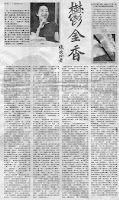
 昨天翻箱倒篋,把長年積聚卻又沒甚用處的文件一個勁地清理了,期間給我找到了一件寶貝,可沒想到自己還留著她的一份剪報(明報 2005.10.2),短短兩年的時間已發黃了不少。
昨天翻箱倒篋,把長年積聚卻又沒甚用處的文件一個勁地清理了,期間給我找到了一件寶貝,可沒想到自己還留著她的一份剪報(明報 2005.10.2),短短兩年的時間已發黃了不少。說來慚愧,這位才女的文采,我著實從沒見識過,或許接觸過一些節錄,但卻沒有好好地讀過一篇。今天,終於碰面。
是一篇很短的愛情故事,聽說佚失了五十八年之久,在她逝世十週年後才正式公開。故事巧妙地交代了主要人物的過去、現在與將來,一點沒有因篇幅所限而草草收筆,很完滿。開始時我心裡還在狐疑:「這麼短的小說,幹麼還著墨在那些沒要緊的人物背景上?」也許我給好萊塢的電影荼毒得過甚了,總想情節推進得快一點,須知這是上世紀中葉的文學作品,那時人們的生活還沒被媒體支配,有多一點的空間觀察周遭的人情世故,自然描述得較為深刻。每個人物的個性都很立體,彷彿腦袋裡已有某某的影子浮現出來了,怪不得文人都崇拜她,字裡行間盡是魅力。
Wednesday, September 12, 2007
Ground Zero
Time flashes.
It's been six years already.
still remember
the moment I watched the news on TV
I froze.
I breathed.
thinking
the Day of Judgment would be coming
very soon
found an interview on TED
http://www.ted.com/talks/view/id/8
with David Rockwell
a prominent architect in NY
talking about how they came up with the idea at
Ground Zero
not too memorial
Serene.
Saturday, September 8, 2007
大娛樂家

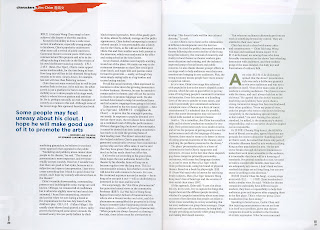
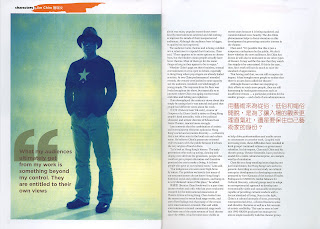

文章嘗試拋出多個問題讓讀者思考,概括多位藝評人及藝術工作者的看法,沒有刻意偏袒或貶低詹氏的作風,那是本地媒體報道應該借鏡的。當中提到一點,大大改變了我對這位笑匠的觀感,那是所有藝術工作者都趨之若鶩的「接觸點」,我不認為票房或資金數目會比這個來得更令一位藝術工作者興奮,不管是甚麼方法,只要開拓了「接觸點」讓觀眾走進劇場,再慢慢來教育他們還不遲,雖然有人質疑當中有多少看過詹氏作品的人會嘗試觀看其他的劇場創作,甚至成為他們恆常的藝術活動?我想就算只有一個又何妨?難得的是那決定性的第一步,許多觀眾或許是首次踏進劇場,要是每每都得計算成效來決定行動與否,藝術普及的一天相信永遠也不會來臨。
不少行內人都怕劇場創作將成另一種服務性行業,只會迎合大眾口味,而這種口味不見得會高尚到哪裡去,藝術只會愈見低俗化。是觀眾造就了詹瑞文還是詹瑞文製造了市場這類先有雞還是蛋的問題已然不重要,沒人會比詹瑞文更早想到低俗化的問題,難道他不擔心長期被定形為喜劇之王,只能賣笑卻未能發展其他類型的劇場創作?但當看到他對劇場教育的熱誠時,也許是大家過慮了。更何況藝術一直都不是主流,又何懼一試?最壞也只不過停留於流而不行的階段罷了,林奕華說的好:He has an ability to click with different people. Because of his high visibility and popularity he has the ear of the people, which not many other artists in Hong Kong do. 藝術家有時也得走出象牙塔,進到人群當中聽聽他們的聲音…讓我們都拭目以待,看看這位大娛樂家怎樣運用他的影響力。
Friday, September 7, 2007
北京呀北京...

上至國際雜誌,下至星斗市民,無不討論你近日的鋒芒,世界頂尖的建築師雲集到你這裡來,打算在黃土上留下永遠的烙印,是的,上百億元的投資,不會是短暫的,這些建築物將永遠成為你的一部份,日後每當人家想起你的時候,不再是天安門紫禁城,而是令人目眩的玻璃窗。
你將逐漸失去安藤忠雄所說的「異稟」,那種「人類的味道」,在你身上都快嗅不出來了,為的是要跟「世界」看齊嗎?但哪裡是「世界」?為什麼你不是那個「世界」?難道除了Norman Foster之外,沒人會設計機場?為何巴黎可以成功地將高樓大廈限制在市內的邊緣地區,甚至可以做到像羅浮宮那樣完美地結合新與舊,你卻忍心移平整個滿有中國特色的胡同?
這是城市化的必經階段還是你一時之間,被虛名沖昏了頭?
Monday, September 3, 2007
Friday, August 24, 2007
Tuesday, August 21, 2007
穿越時空的少女

上星期看的是優先場,正式公映要到8月23日,比日本版遲了足足一年。說的是老生常談的主題──時間,但故事情節卻充滿時代感,一點不覺得土氣。人生都有太多的遺憾,要是可以重來的話該有多好?當然,這都是我們一廂情願的想法,大概不會想到再來一次的話,可能比原來的情況更糟,主角真琴當然沒想到這一點,自顧自地穿梭於時空長廊裡,開心來着卻一點沒考慮身邊人的感受,前部份的「任性」使後來的「痛悔」更具震撼力,雖然早有心理準備,還是看得我酸溜溜的。畢竟這是一套動畫,總得有個美麗的結局,不管多麼牽強。
友人說日本的平面設計都很講究美,但不都能使人明白,要是指着這套電影說的話,是成立的,因為要是理性一點思考的話,兩位主角最終是不可能踫面的,但當我離開影院的時候,腦子裡憧憬的,盡是美麗的畫面…
Design Critics

“Art is high and Design is low”
這是我們設計人大都知道的,Design從來都被視作依附商業而生的一種工具,為的是提高人類的生活質素(正確一點,是我們的消費意欲),它最多只能被稱為 Commercial Art,與所謂的Popular Culture密不可分,但想要走進藝術正典的殿堂,相信還有一段距離,而這段距離是怎樣形成的呢?那篇文章提到了一個值得深思的現象:為何我們從來沒有在媒體當中看過一個正正經經的Design Critics專欄?我這才想起每期的Newsweek都會把設計產品放在一個名為“The Good Life”的欄目,跟所有消費品沒兩樣,就是在文化博物館看到的設計展,也不會找來甚麼設計評論家(還不肯定有沒有這樣的頭銜)跟大家解說解說,似乎設計品本身就不值得評論。
然而我們不難發現設計師的地位已較十多二十年前提升了不少,在“How to be a graphic designer without losing your soul”一書中便提到今天的美國,當你告訴人家你是一名設計師,已不會再有人視你為脫衣舞孃一樣。我們多多少少會聽過這些名字:Stefan Sagmeister, Michael Rock, Susan Sellers, Paula Scher;本土的也有Alan Chan, Tommi Li, Hung Lam, Sandy Choi…設計界有無數粒明星,每天佔據媒體的篇幅也不少,但卻無助設計獲得與藝術同等的尊重及認同,而重災區更是平面設計。
與大家分享兩個很好的設計評論網,不妨定期上去看看,你的設計視野會變得不一樣,就讓我們一起來提高設計的地位。
1) UnderConsideration – a growing network and enterprise dedicated to the progress of the graphic design profession and its practitioners, students and enthusiasts.
http://www.underconsideration.com/
2) DesignObserver – writings on design and culture
http://www.designobserver.com/
Thursday, August 16, 2007
NIKE vs Adidas Transformer
早前看過 Steven Spielburg 的 "Tranformer",總覺特技賣弄得有點過了火,這隻NIKE鞋算是變形得合理一點...
對手的另一種 transformation,也很不錯...
Sunday, August 12, 2007
The First Digital Play in Theatre
 Newsweek, Aug 6, 2007
Newsweek, Aug 6, 2007What strike me most is not how groundbreaking the news is but that electronic media finally intrude theatre, one of the most fundamental forms of art in human history. Theatre, when compared to other art forms, always deals with the 'present'. No play is prerecorded. If John Chris Jones, pioneer in the design methods movement in 60s, identified the main point of difference between art and design is that of timing, theatre is undoubtedly a place for an artist to manipulate a medium that exists at the same time as his actions. (Design Methods, p11) He acts in 'real time'. Every performance is therefore unique and cannot be replicated apple to apple. That on one hand hides the most valuable virtue of art, while on the other, implies the inevasible presence of uncertainty in each performance. And now this kind of uncertainty may well be intensified by the spontaneous reaction from the spectators.
In spite of clear instructions from the actors, the choice to participate or not still belongs to the floor. A few contingency plans may have to be prepared in case of no response or technical instabilities. On behalf of audience, as mentioned in the article, it becomes more and more difficult to comprehend the play, which now requires additional amount of patience and attention to follow the plot. As more and more personalized experience is allowed with all these advance technologies, I begin to worry that discussion of views among audiences will become increasingly difficult due to a lack of common ground. We can discuss on a film because we have watched the 'same' film. If 'what we hear depends on where we sit', we can only 'share' our unique experience but not 'discuss' or even 'criticize' on a particular part.
I suddenly got a weird thought: what would happen if I forgot to bring my cell phone when attending such kind of digital play in the future? No matter what, one aspect may be well received by Hong Kong audiences: they no longer have to switch off their cell phones before a performance starts!
Friday, August 10, 2007
"habitus" closing down
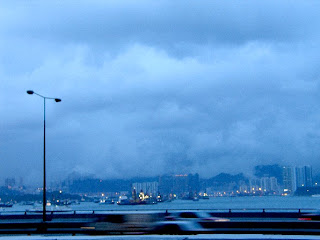
Last week, we were notified by our landlord that we had to move out by the end of this month from the third floor of the Western Market, to make way for a marriage registry-related business.
Sad but not surprising, the news came with an "offer" from the depth of a well-oiled mercenary spirit. We may like to rent a ground floor unit next to the dessert store in the same historical building for HK$60,000/ month, a unit of around 600 square feet. For those of you interested, please contact the landlord directly. We sensed major tenancy shuffling is in place there. The unit is way beyond what we could afford, mentally, emotionally, and financially.
"ALL MUST GO" SALE NOW ON.
Aug 9 and 16 (Thurs) 1-6pm
Aug 10-12 & Aug 17-19 (Fri to Sun) 11am-7pm
Thursday, August 9, 2007
Friday, July 27, 2007
Thursday, July 26, 2007
亞洲文化合作論壇2007
源於前兩天參加的亞洲文化合作論壇,當中提到了許多值得思考的議題,特別是最後一場由詹瑞文和歐陽應霽負責主講有關「越界」(Cross-over) 的討論,讓我再次思考到「藝術」與「商業藝術」的分野,顯然中間只剩那點點的虛線了。
過去藝術家不屑與商家合作,以防自己的作品沾上銅臭,有損名節,大底我們印象中的偉大藝術家,都如Vincent van Gogh那樣至死不得溫飽,又或像電影《鐵達尼號》裏的Jack Dawson,沒錢買船票之餘,還得睡在三等艙,畫的都是被主流社會唾棄的妓女;然而正因着這種堅持與傲骨,尋常百姓對藝術家總會有種莫名的欣賞與佩服,他們流露的“氣質”,大概也源於此。記得以前許多唸設計的同學原意唸藝術,奈何擔心畢業後難找工作,才選擇設計,所以藝術系又名「渣兜」系,意指進去後便註定要托缽討飯。
沒想到討論會上發出的第一道問題便是Can professional artists secure their future? 為何時至今日,還在討論這個問題?是否告訴我們只有極少數成了名(在流行文化當中佔上一席位)的藝術家的未來才有保障?現在不少藝術家都願意與商界合作,做品牌代言人、拍廣告,不但不會被指出賣藝術,還被視為跨媒體創作人,知名度提高的同時,亦不用再擔心資金來源,“創作”一詞似是把背後所有互惠互利的關係過濾得一乾二淨。
詹氏指他們嘗試把劇場帶到群眾當中,用他們的語言來跟他們對話,發掘這門藝術新的可能性,在劇團成立之始,他們便構想到劇場需要一位明星,觀眾才會走進去。這不正是在運用資本主義社會的運作模式去讓藝術生存下來嗎?是在用他們的語言說話還是迎合公眾口味?我當然不贊成藝術永遠都高高在上,望塵莫及,但也值得思考為何我們會視那些為藝術?影視藝人也被喚作Artist,但我們不會把他們視為藝術家,只怕我們都在濫用「藝術」或「創作」一詞,正如會上有講者認為我們都在濫用Creative一字,就連會計師也被形容為 creative,是怎麼一回事?
很喜歡著名實驗電影導演及學者Maya Deren所形容的「藝術家」,在其著作An Anagram of Ideas on Art, Form and Film中,她提到:For the serious artist the esthetic problem of form is, essentially, and simultaneously, a moral problem. Nothing can account for the devoted dedication of the giants of human history to art form save the understanding that, for them, the moral and esthetic problems were one and the same: that the form of a work of art is the physical manifestation of its moral structure.
Deren相信美學與道德倫理密不可分,美本身並不單是一種選擇,而是在物質層面上有意識地呈現出來的一種人文精神。
The work of art is skin for an idea. It must also illuminate certain ethical or moral principles as well as comprehend the large facts of its total culture, and, at best, extend them imaginatively.
與友人均有同感的是,每一種藝術本身的可能性已夠一位藝術家窮一生之力去探索,是一段漫長的尋找過程,畢卡索創作了多少幅寫實的畫作才來到立體主義?跨媒體(特別是跨潮流文化的)創作有多少是在搞噱頭(gimmick)多於搞藝術?而又有多少是藝術家本身對原來的發展方向缺乏堅持,因此走到另一領域去尋找新的機會?聽說第一個找藝術家來合作的品牌是Absolute Vodka,跟Andy Warhol的合作可謂空前成功,其後Vodka繼續與不同的插圖家及建築家合作,建立了品牌獨有的個性,今天不知多少品牌都在套用這個點子?
「現在愈來愈難欣賞到純粹的藝術。」是我們都有太多的目的要達到吧!
Sunday, July 22, 2007
Saturday, July 21, 2007
今年買書特別少...
Tuesday, July 17, 2007
If you said yes to abortion...
Tuesday, July 10, 2007
Saturday, July 7, 2007
A MESSAGE TO THE FUTURE A MESSAGE FROM THE PAST
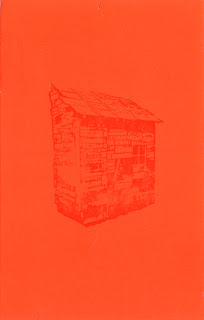
真好,在Socially Yours的座談會上踫見黃國才(Kacey Wong)。
就他為Victoria Prison Art Museum所造的黃色小木屋,我說了點自己的看法,他顯然不太認同,但因下半場的節目即將開始,他沒能解釋下去,好可惜,真想聽聽藝術家親自為自己的作品發聲。多年前曾聽一學者說:「一件作品自公開以後,作者便失去了對其作品本身的詮釋權。」畢加索有過類似的話,但是指着觀眾說的:「任何一個人要對一幅畫作出解釋都是找錯了對象。」那麼是否都不要作任何理解呢?你刻意地要傳遞某些訊息,作為接收者的我難道便不能釐清這個訊息是甚麼嗎?我想一件好的作品,值得觀眾一想再想。
他刻意地在一個空間內營造了另一個空間。
先說我第一次的觀後感。我認為他沒有好好地運用現存的室內空間,亦沒有把囚室當囚室般用,觀眾一進去便給那小木屋吸引着,像個小孩看見糖果屋一様,爭相擠進去看個究竟,較比起其他同場的藝術品,囚室這個硬件在黃國才的作品中看似可有可無,要是把小屋獨置在其他地點,效果也不會相差太遠。我有這個想法,似乎是誤把小木屋當作一獨立自存的囚室看待,把它從本來的那個空間分割出來了。
監獄把罪犯與世界隔絕,一間間獨立的囚室再將罪犯們分開,最後這間小屋再邀請犯人把另一個自己分別出來。內心深處總有甚麼話要說吧,請化作文字留給未來那個重獲自由的自己,到那日,看着自己當年初到貴境的留言,不知會是怎樣的心情?觀眾被邀請站在這條時間線上的兩點,然而兩點卻同時並置在同一空間(小木屋)內,這種時間與空間的接軌讓我想起黃國才多年前的另一件作品,多個由大至小的黃色木屋以直線排列而成,從正面的“門口”窺探入內,會形成一點透視的錯覺,當觀眾誤以為可以走進這條長廊時,才發現門口不斷在縮小,限制你繼續前行,這種空間的虛置正正衝擊着我們固有的視覺經驗,你以為它很遙遠嗎?其實只有幾步的路程。黃氏的作品看來都很安靜,卻時刻充滿着令人躍躍欲試的互動性。
後來在其網站內找到以下一段小小的題旨,果然,用心一點看可以更貼近原意:
A philosopher once said the only freedom that ever exists is the freedom to choose whatever to think inside our mind. The memory of our past might not be what really happened. What are the things you wanted to change in your memory? What message do you have for your future? I built a wooden cabin out of recycle wood completed with a garden inside the tiny cell. Inside you can contemplate and reflect quietly then write a postcard addressing to your future self, I will mail it back to you in the future.
Friday, July 6, 2007
Socially Yours - Alternative Design Networking Seminar
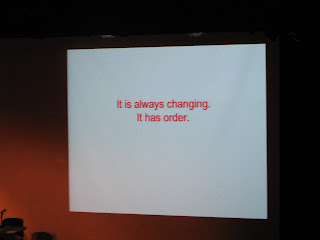
當看見人家從老遠帶來的概念和創作經驗時,本地的藝術工作者汲取了些甚麼?正如當中一位有份參與“Blue House”計劃的荷蘭藝術家Jeanne van Heeswijk提到,不論是甚麼活動都有機會遇上未知的困難,他們這個計劃不是也給當地政府起訴過無數次?但重要的是踏出第一步,那最不明朗的一步,光想着前頭諸般的障礙而猶豫不決,結果只會甚麼都做不來,最後分享的香港建築師羅健中先生不是一個活生生的見證嗎?儘管預計到政府很大可能會反對他們的計劃,但依然提交心目中認為最切合該區居民的設計方案,除為他們帶來獎項之餘,更間接地衝擊着大眾對舊區重建與規劃的一些錯誤觀念。
設計不再是一人獨專的產物,而是與大眾互動的成果,Brian Lee的木頭桌雖然不是甚麼大堆頭項目,但在設計的過程中讓老人家重新肯定自己的再生能力和社會意義,那才是真正的Humanistic Design。Design for the Community未必一定合乎經濟效益,但若能使這個是非之都和諧一點,不是已經很有價值了嗎?
Sunday, July 1, 2007
珈琲時光 -------東京物語
Tuesday, June 26, 2007
Exhibition Day
Wednesday, June 6, 2007
六四成人禮



跟爸爸一起來,特別有意思。記得第一次看見爸哭,便是某一年的六四,大家都在用膳,電視機正播放當年的片段…我不明白,事情有那麼嚴重嗎?爸爸可不是當年的大學生。
「有多少父母就這樣喪掉孩子?」
他忽地吐出那麼一句,這才發現他臉上沾着淚水…
後來六四十週年,學校辦了一個特別週會,播放了一段當時的紀錄片,看着被血紅渲染的畫面,我這才懂得哭,是的,我們應該為他們哭。
每年都有想過到維園走一趟,總是提不起勁,也許我希望有人能陪我壯壯膽。第一年參加七一大遊行也是他先提出的,終於明白甚麼叫“薪火相傳”,需要的不是單純的口號,而是身體力行,這一點爸爸做到了。
還沒到達現場,氣氛已相當濃厚,那些邊抓著飯盒邊往前推進的少年人讓我覺得香港的未來充滿希望,雖然不是每一個到場的都是為了平反六四,可為了讓這點標誌著香港在一國兩制下仍享有言論和集會自由的燭光得以延續下去,出一點綿力又如何?試想一天,連香港也不能悼念六四的時候,會是怎樣的光境?
Sunday, June 3, 2007
旁觀者 I
原文載於 NewDesignMagazine HKArticle, 2007 April14:
Opportunities. That is what defines life as a student industrial designer in Hong Kong. Everywhere there are chances, new possibilities and open doors. Young designers are in demand and whilst students in the UK can struggle to find the most mundane of placements, opportunities for talented designers are abundant in Hong Kong.
Our class had only 45 members (compared to the 150 in Coventry) and tutor contact time was twice weekly for each subject. Local students almost lived out of their studios, each work space not only containing piles of work, but dozens of personal possessions. It was no wonder that many of them would often not go home during the week and sleep at their desks.Expectations on students are different in Hong Kong. Whilst in the UK our experience has been one where lecturers are passive and allow students to mature and develop on their own, here the information and technical knowledge is force fed into students, producing young designers who posses immense levels of computer-based design skill but also all share the same design philosophy. This apparent lack of individualism and even creativity is not so much through the teaching at the university, but more through the general education system in Hong Kong.
Indeed, the broadly experienced international lecturers actively encourages in-depth thinking and concentration on a strong concept over superficial aesthetic details, but are constantly fighting the ingrained conformism that seems to be a product of the secondary education in Hong Kong. Consequently, local work was very different to what we knew and we had to make a significant shift in our style to fit into the course. Hong Kong students have a love of technology and anything computer related and this translates into CAD skills that put many UK professionals to shame. Likewise, their presentation skills were initially in a different league to what was expected in Coventry and although this often came at the expense of strong concepts, it is a design approach that suits Hong Kong.
For us, it was a surprise to find so many of the local students taking freelance design work: they would be designing USB sticks and other small products in their spare time, as well as using their significant graphic design skills to create packaging and advertising. This ability to find quick, simple and well paid design work part time was perhaps the biggest shock for us and the most encouraging development of our time in Hong Kong. However, the blurring of the boundary between student and paid designer came at a cost: the local students work so much harder than many of their contemporaries in the UK yet often lacked clear, directed conceptual ability in favour of design for quick, cheap manufacture.The reason for the amount of available work, especially for young designers with fresh ideas is simple: Gunagdong Province of China is just across the border and is the largest manufacturing hub in the world. A product of this is dozens of busy, profitable design consultancies in Hong Kong actively seeking international design staff and students like us were in a perfect position to find experience.There is a strong ex-pat community, many of whom are senior designers in local consultancies and all were looking to hire both local and foreign students.
The compact nature of Hong Kong means that networking is easy and it didn't take long for our names to be passed between designers and for internship interviews to be set up with very little pestering on our behalf. This nurturing, friendly attitude towards young designers is so refreshing to the closed-door policy adopted by firms towards students in the UK and over the next few weeks, we have interviews with several major companies, something undreamt of for inexperienced designers like us.
Saturday, June 2, 2007
設計毒癮
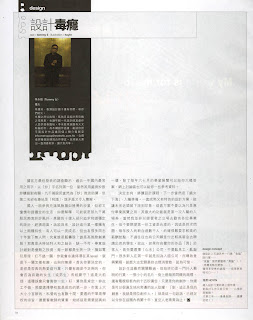
If someone tells you that design is about rules breaking, he'll be a lawyer;
if he tells you that design is about problem solving, he'll be an engineer;
if he tells you that design is about improving our lives, he'll be another Hitler.
“在香港從事平面設計或書籍設計,實在有太多太多的限制;而我們所要做的,就是在這多重限制之下,讓那創意有一小點的發揮空間。我常常在想,設計不須要是一個非常偉大的職業或我不須要成為一個偉大的設計工作者,我只希望我的設計作品能帶到一點點歡樂、驚喜或滿足感給讀者,讓他/她在生命的過程裡多一絲的笑容,已經很滿足了。我身為讀者的經驗是:每買一期日本雜誌「+81」,還未看內容,只看 layout,那種開心興奮的感覺已自動湧上心頭,這就是設計所帶來的快感。”
曾有許多行內人揚言做設計的都期盼有朝一日能成立自家公司或品牌,在這行頭打滾,為的是汲取經驗,打通人際網絡,那麼多時裝設計人爭相上《Project Runway》,還不是希望他朝看見街上有人穿上印有自己名字的時裝?但筆者認為最讓人對設計心癢的還是那份創作帶來的滿足感和優越感,不然幹麼還有那麼多人開不了公司、做不到AD,仍舊留守在這個磨心磨力的行業?正如Tommy Li於上一期Metropop《設計毒癮》一文中提到的,就是人家那麼一句欣賞的話,便足以令一個設計人心甘情願地花上多年的光華歲月,在行內做個平凡設計人。是甚麼設計哲學已經不重要了,重要的是人們看過設計後那點點窩心的回應,看似微不足道,卻是推動每個設計師前進的原始動能。
話說回來,因習慣了這種工作模式而留在這一行的也大有人在,到了某個年紀又不願重新適應新環境或學習新技能,就更難轉行,是否真愛設計,誰曉得?近陣子正在做一個有關設計學生思考過程的項目,問到為何當初選修設計,都是糊裡糊塗地闖了進來,談不上喜歡不喜歡,更莫說對設計有任何熱誠,奈何他們都擁有一身不錯的“軟件功”,身兼多份兼職。難怪市面上都充斥着許多有形無實的產品,“實”指的是產品的靈魂──概念,而非單純的漂亮外殼。
Tuesday, May 22, 2007
Francois Ozon - X2000

Director(s): Francois Ozon
Actors: Lucia Sanchez, Lionel Le Guevellou, Flavien Coupeau, Denise Aron-Schropfer, Bruno Slagmulder
Languages: French
Subtitles: English
Screen: Color
Length: 61 minutes
Country of origin: France
Year Filmed: 1998
想不到這次到廈門參加親戚的婚禮,竟有機會看到Francois Ozon的舊作X2000,他執導的電影我看過三部,這是第四部。
Monday, May 21, 2007
《最後的晚餐》
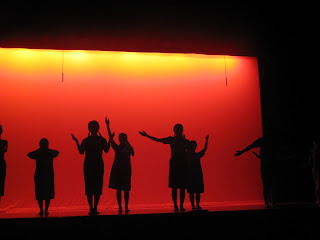
-彼德‧布魯克
"A man walks across whilst someone else is watching, this is all that is needed for an act of theatre to be engaged. "
- Peter Brook
應好友之邀,第一次參加劇場創作,沒甚期望,倒是怕自己外行,連累他人,畢竟是場比賽,總不能馬虎了事。我負責的是舞台/佈景設計。剛開始時先問自己:甚麼是劇場?恰好在一份宣傳品上找到這句子。構成劇場的最基本元素只有演員和觀眾,舞台上的其他東西相對而言只是陪襯品,最「簡約」的時候都可以刪掉,正如默劇,演員的身體語言已足夠傳情達意,不一定要有椅子,你才明白那人正在車廂中看報紙,“意會”有時候比“看見”來得有趣。那麼,一個舞台在甚麼時候需要加插佈景/道具/燈光?為何今天當我們一提到劇場,這些都似乎缺一不可?
二十世紀德國著名的劇作家Bertolt Brecht在完成了The Rise and Fall of the City of Mahagony之後論到當時的歌劇均為娛樂而生,難逃被商品化,其講究的是“經驗”所帶來的快感以及“品味”的培育。但當劇目的“娛樂性”越強,其距離“真實性”便越遠:一個將死的角色是真實的元素,當他同時歌唱的時候,便引領我們進入一非理性的層面去詮釋內容,有時候這種處理手法甚至會為故事帶來顛覆性的效果,當各舞台元素的互補關係被瓦解後,觀眾便不再單純地坐着被餵養,而是被邀請進入思考批判的層面,所謂的“諷刺作品”[Satire]便是這麼一回事。
看過劇本後,已粗略知道需要那些道具,用以交代場景變化,使之更具真實性,但若要進到另一層次,刺激觀眾思考的話,佈景/道具/燈光便不能跟着劇本走。全劇讓人最深刻的,不正是開始時最不真實的一幕?(上圖)
Sunday, April 29, 2007
Adobe CS3 Launch Seminar

oh... i want to be that lucky winner for CS3 Premium Pack!! To be honest, CS3 is a quantum leap forward. At least AI won't shut down again when working together with Photoshop, but all those fantastic features seemed to facilitate works on multi-disciplinary design, which was used to be delivered by several design firms at the same time. Now, design firms that mainly specialized in editorial design may well be entertaining clients with all sorts of design deliverables ranging from web design to video promos.
Guided by such phenomenon, fresh design graduates are mostly equipped with various kinds of design software so as to maintain fair competence among peers, which is in some ways more and more difficult for students who entered the field not until F.7 to catch up with peers that had already gone through basic design thinking and technical training in their earlier years in IVE or other design institutes. Then does it mean that you had better quit your normal education and focus on design training if you find your interest in an early age?
For me, the answer would be fifty-fifty. As learnt from my past experience or even based on my recent research project, students who receive design education after completing high school are usually found to possess strong conceptual thinking ability and develop a more sophisticated project that produces fruitful research on a wide range of social and cultural issues. In return, they may lacked the ability or skills to actualize their design concepts. Sometimes they even struggle a lot on how to translate those rich research materials into visible design ideas. But this is seldom a big obstacle for students coming from IVE or high dip. They used to move on to execution stage earlier and spent most of their time working on a presentable outcome. Their concepts may be comparatively shallower but audiences were often satisfied by what was presented in front of them. After all, they had skills.
Thursday, April 26, 2007
Cape Farewell
今天在街上看見許多「吊帶人士」,還是四月天,我想,夠切身的了。
Tuesday, April 24, 2007
Monday, April 23, 2007
Excuse me...
Sunday, April 22, 2007
Victoria Prison Art Museum

沒想到自己對中環會是如斯陌生,與友人圈了大半天方到達展覽會場,還給一名內地阿叔(踫巧問着一位國語人)誤以為我們是港燦,竟連「域多利監獄」也不會去!
細雨紛紛,要不是參觀者眾,會場定會格外肅清。被囚者的天空,我想,本來就是這樣的吧?多位本地藝術家嘗試帶領觀眾進入他們的天空,一個給世人遺忘了的國度。
難忘從那狹小得僅容一人擠身的木屋往外看,不變的尺寸、不變的角度、不變的內容,變的是分秒的流逝,光華的不再,黃國才的作品正不斷地試探着觀眾的能耐──你,可以在這樣的空間逗留多久?走過數間囚室,奇怪作品的表現手法竟會如斯類同,大家都不約而同地用到塑膠玩偶:被肢解、侵犯、襲擊,這是再一次控訴被囚者的惡行還是他們當下的心情?血紅色的調子叫人不願久留,走廊盡處卻是柳暗花明,一群潔白的鴿子沿梯而上,象徵着無罪與釋放,空間運用得宜,亦擺脫了各囚室的沉重,要是多一點這樣情緒的作品,我會喜歡這個展覽多一點。
Friday, April 20, 2007
二零零七年四月二十日
don't know why but all of a sudden, i want to start a blog...
just drop by MoMA's website and find a sculpture by David Smith, which is so much similar to a sketch bull by Pablo Picasso! (it's been my wallpaper for quite a while already)
no wonder why...
"I do not recognize the limits where painting ends and sculpture begins." So said Smith, who, in making Australia, used thin rods and plates of steel—simultaneously delicate and strong—to paint in space. Like a painting, Australia must be seen frontally if its form is to be grasped. It has been identified as an abstraction of a kangaroo, and its lines have that animal's leaping vitality. Though he began his career as a painter, Smith was inspired to make welded metal sculptures in 1930 when he saw those made by Pablo Picasso and Julio González. [extract from MoMA's website]






